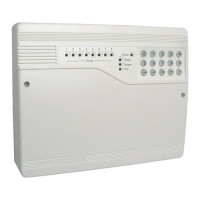
Do you have a question about the ADE Optima and is the answer not in the manual?
| Tamper Circuit | Yes |
|---|---|
| Remote Signalling | Yes, via telephone line or GSM module |
| Standby Battery | 7Ah rechargeable battery |
| Wireless Zones | Yes, with optional wireless receiver |
| Keypads Supported | Up to 4 |
| Outputs | programmable outputs |
| Communication | PSTN, GSM/GPRS (optional) |
| Zones | 8–32 |
Details default customer code, engineer code, and access restrictions for programming.
Outlines common faults like incorrect wiring, fuse issues, and tamper/PA fault lockouts.
Provides steps for diagnosing faults, including wiring checks and system resets.
Emphasizes caution and isolation when working near the mains supply.
System disarmed state; only tamper and PA inputs are active.
Procedure for arming the system, including code entry and zone omission.
How to disarm the system using the customer code.
Handling alarms, stopping sounders, and returning the system to Day mode.
Details functions of Zone 1 (timed), Zone 2 (entry route), and Zones 3 & 4 (immediate).
Explains tamper network protection and personal attack button connections.
Describes internal sounder, external bell output, and strobe output functions.
Covers battery backup, 13V output, Set+Ve, fuses, and Non-Volatile Memory.
How to access and view the last alarm condition from the customer programme.
Overview of customer and engineer programming modes.
Steps to change the customer code.
Configuration of Exit Time and Entry Time.
Procedures for testing strobe, bell, sounder, and walk test.
Procedure to restore the system to its original factory settings.
Planning cable routes, siting components, and considering current outputs.
Steps for removing the PCB, mounting the base, and refitting.
Instructions for bringing cables to the panel and forming them neatly.
Procedure for connecting battery and initial wiring checks.
Procedure to clear NVM and return to factory settings.
Guidelines for connecting the mains supply, including safety warnings.
Final checks, programming, testing, and customer explanation.
Accessing code change, alarm memory recall, and alarm tests.
Instructions for arming the system, including handling zone faults.
Instructions for disarming the system and clearing alarms.
Procedure for omitting specific zones during the setting process.
How to quickly set the system without the full exit delay.
Checks for power indicator status and advice on handling faults.